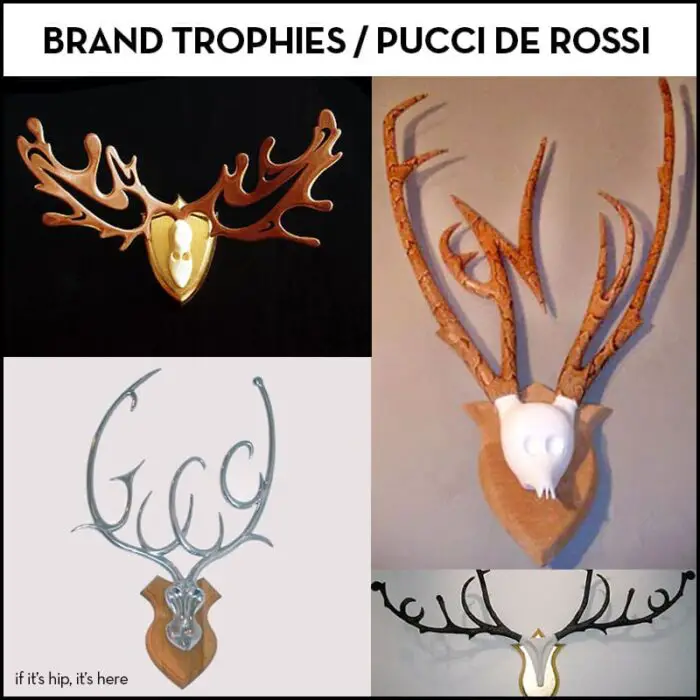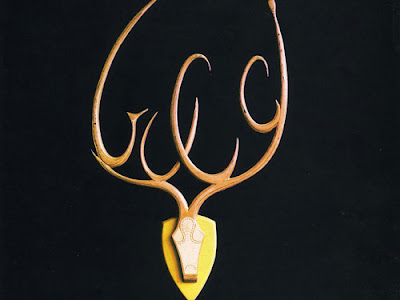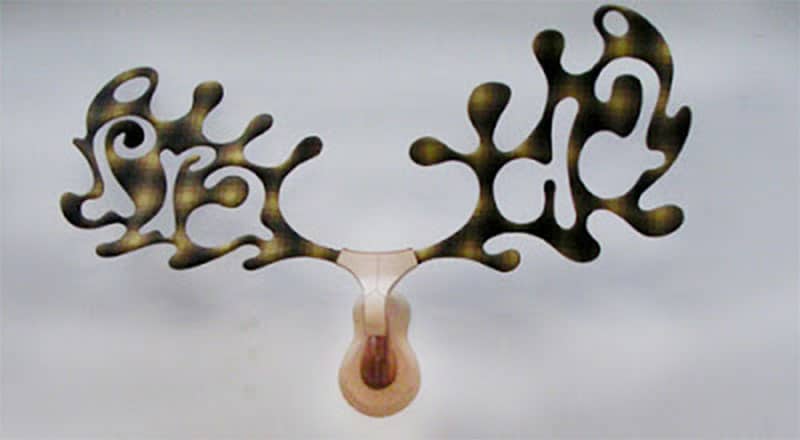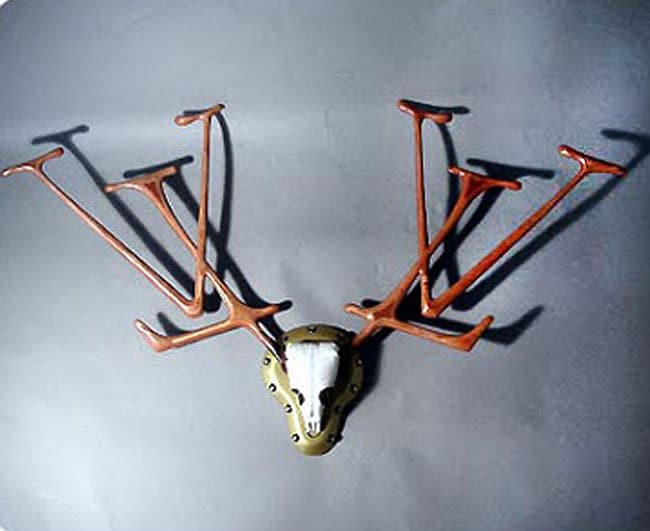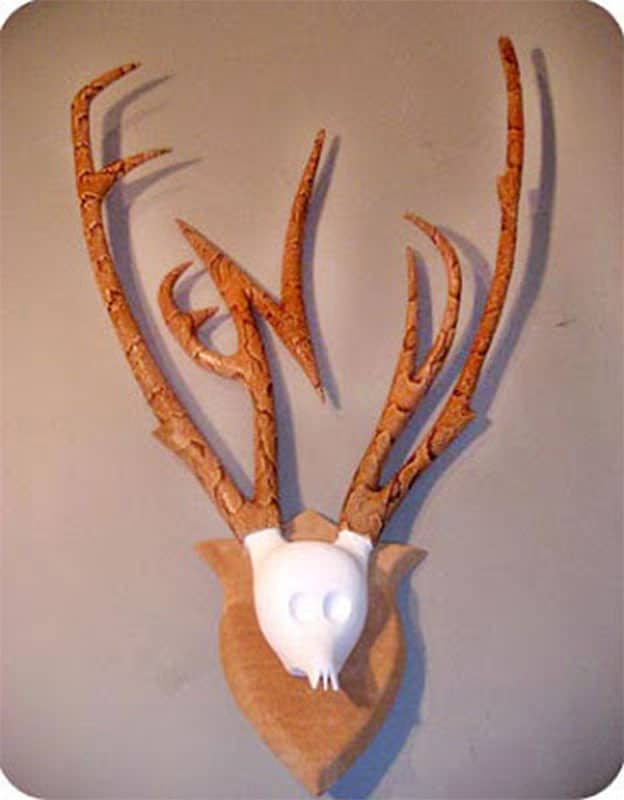What at first appear to be stylized wall mounted animal head trophies made of steel, wood, ceramic, plaster and leather, when examined more closely, contain famous brand names such as Cartier, Gucci, Prada, LV, Danone, McDonalds, Coca Cola, Nike and more (some surreptitiously) within the horns.
Pucci de Rossi Brand Trophies
Pucci de Rossi Brand Trophies compare luxury brand shopping to the tradition of hunting with mounted heads in whose horns hide logos.

Pucci de Rossi Brand Trophies, also referred to as ‘Shopping Trophies’ or ‘Metropolitan Trophies’, are a commentary on marketing and a comparison of contemporary art with the tradition of hunting. A surrealistic representation of how trademarks and brand names have infiltrated our society to such a point that they have attained an almost mythical significance. Even when taken out of their natural context, separated from the products they represent, they continue to have loyalty and value attached to them.” – Alexandra Senes, Brand Tyranny
above: Installation view at the galerie Anne de Villepoix
Each trophy is hand-crafted and there are multiple versions of certain pieces in various materials as you will see from the images below. The show exhibited at galerie Anne de Villepoix in Paris under the name of “Têtes bizardes” (trophées de chasse métropolitains) in 2003.
Gucci:
Prada:
Louis Vuitton:
Cartier:
Fendi:
Dior:
Coca Cola:
McDonalds:
Nike:
Nike -Texas:
Danone:
Others in the collection are simply ornate:
above: Pucci de Rossi (photo: Anne-Sophie Granjon)
The designer Pucci de Rossi, a sort of Italian Gyro Gearloose (the Disney-created madcap inventor) has always tended to joke about everything. The focus is now on his provocative logo sculptures. Hunting in Le Marais district of Paris: magnificent and disconcerting, weird sculptures are growing on the walls of a Parisian gallery in the “Shopping Trophies” exhibition. These trophies, with their sensuous and erotic curves, like some kind of extra-terrestrial fauna slain in the course of an imaginary hunt, are set to disconcert us by exhibiting between their antlers familiar logos such as those of Nike, MacDonald’s, Cartier, Gucci and Prada. Their creator, Pucci de Rossi, has always pushed luxury to its limits, asserting both its usefulness and uselessness.
This time, he alienates everyday realities from their usual meaning by juxtaposing them with their apparent opposites: nature versus culture… brand culture. A tone of cynical derision together with a craftsman’s expertise testifies to the symptoms of an industrial society polluted by logos which endlessly invade our field of vision. Values which consumers, for want of any clear direction, identify with when making their purchases. Values which have become a refuge in a world that is undergoing an identity crisis.
Customisation in limited series.
These sculptures display a panorama of an era. Through them, Pucci questions and subverts the image of advertising. These luxury brands, trophies of a kind (an insult to the language of hunting), which we flaunt more or less ostentatiously, these exotic antlers are the mouthpiece for anti-consumerist messages. With the arrogance of a seasoned “domestic hunter”, Pucci sets out to explore and reflect on this. Now that he has got over the monochromatic silence of his minimalist period, his liberated and unpretentious trophies speak out amid the cacophony of provocative logos. Pucci uses these capitalist symbols and logos as the instrument of his revolt. “We are all prostitutes who’ll go with the first punter. “
Far removed from political manifestos, his art plays with the customisation of limited series, and his sculptures stage an ephemeral image of a certain section of our society. In keeping with this sense of humour, these logos are an inspiration to the imagination, showing how an independent mentality could be exhibited. Depending on your mood, you could exhibit your fascination with chaos and your hatred of confusion on a wall in your apartment. Provocatively, Pucci takes a particular prop or pretext and invents a new form of media, developed from his work: creative resistance to globalisation. “Globalisation is a subject I find both troubling and challenging and which I considered sufficiently important for me to tackle and do something with.”
Exorcising the marketing element ”Paradoxically, by exhibiting these brands, I am, in effect, glorifying them. But it is also an animal that I have slain and defeated. A way of exorcising it.” Being allergic to marketing, he does not censor himself: from his condemnation of the power of multinationals to anti-globalisation demonstrations, everything is the object of his critique. And should one suspect him of wanting to “act like a cheap salesman”, he transforms his client into a vengeful buyer who ends up by following him, willingly, thanks to his lively language that overrides jargon. (published in magazine Jealous n°64, Octobre 2003)
images courtesy of the artist, made75 and the gallery
